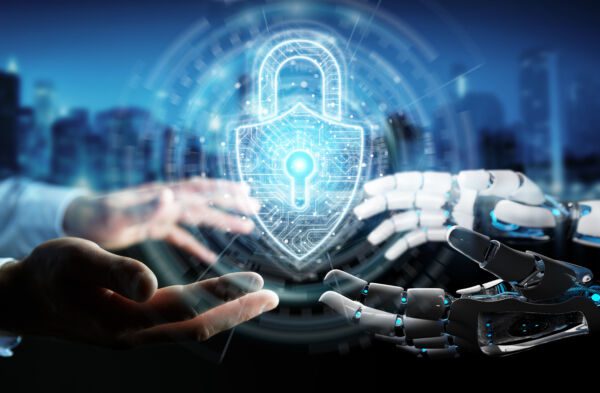Cybersecurity and artificial intelligence – for some, this combination probably sounds like a digital threat and makes them think of bots, dangerous algorithms or spam. The good news is that while AI can use such methods, they can also defend against them. Because with the help of AI and Machine Learning (ML), workflows can be transformed into efficient, autonomous, and continuous processes that reduces your organization’s exposure to cyberattacks.
Artificial intelligence (AI) can automate human thinking and thus implement processes more quickly. These technologies receive certain information based on which they can understand, learn and act. What may still sound like science fiction is already reality in many areas:
We use AI in search engines, translator programs, digital analyses and forecasts (e.g. for stock price developments), voice assistants such as Siri, social bots and much more. So everyone has already been assisted by artificial intelligence in one way or another.
Machine Learning (ML) is a subfield of Artificial Intelligence. In fact, they are often used interchangeably, as ML uses statistical techniques to give computer systems the ability to learn to use data. Another subset of this is Deep Learning (DL), which imitates human learning behavior using large amounts of data and can thus recognize specific patterns, especially quickly.

What Role Does AI Play In Cybersecurity?
Artificial intelligence can support a company’s cybersecurity division in a variety of ways. We’ve compiled the 6 most helpful ways AI can help SMEs here:
- Hazard detection
- Behavioral analysis
- Risk assessment
- AI as a shield
- Improved Endpoint Protection
- Faster detection and response times
6 Opportunities For AI Processes & Cybersecurity
1. Hazard detection
Using pattern recognition, artificial intelligence can characterize and detect threats at an early stage. More and more IT professionals are using AI and machine learning solutions as they can prevent false positives in early detection. They are also incredibly time-saving. If an AI is properly trained, it can recognize unusual patterns within a very short time and thus detect hidden channels through which data is siphoned off.
2. Behavioral analysis
Artificial intelligence can also be used to identify past, current, and expected behaviors to more quickly detect suspicious activity. Using AI to understand the behaviors of IT or OT (operational technology) systems can prevent policy or activity violations before human teams would have even detected them. Sometimes these attacks or threats are so novel that there are not yet well-defined detection signatures that IT professionals would need to notice them. In contrast, Machine Learning of an Artificial Intelligence can examine many behavioral profiles, compare them with each other and thus draw conclusions faster.
3. Risk assessment
It is essential for a company to know its vulnerabilities in order to secure a network. In addition to the pure recognition of dangers and conspicuous behavioral patterns, it is also important to assess how dangerous these deviations are. Artificial intelligence can determine the likelihood and impact of vulnerabilities, and therefore the potential threat to a system and its associated business. On this basis, companies can make informed decisions to minimize risks.
4. AI as a shield
AI can also defend against and target cyberattacks in a variety of ways. For example, spam mails can be identified far beyond normal filters. With an AI solution, it is possible to identify complex patterns and structures in this regard and actively block them accordingly. The same is true for malware – modern AIs can not only automatically fend off malware, but also evolve to the point where they can detect ransomware before it encrypts data. Bots are also often a form of AI that attack systems or spread spam, so AI can work against AI here.
5. Improved Endpoint Protection
Endpoint Protection is a particularly important aspect for SMEs. This includes securing your endpoints, such as work laptops used by your employees in the home office. Since such a device is connected to the corporate network, extra care must be taken here to prevent malware or ransomware from creeping in and corrupting the entire network. AI and machine learning can also be used to detect new, sophisticated attack methods on their own. Their intelligent algorithms independently analyze systems for anomalies and security risks and can often stop them directly.
6. Faster detection and response times
The previously mentioned points unite here, because Artificial Intelligence is especially fast and effective. By recognizing patterns in seconds, it is far superior to human reaction times. Still, IT and AI experts are needed to give AI the tools it needs and to do the fine-tuning so that, over time, AI learns exactly what patterns to recognize and what to respond to.
Artificial Intelligence – the Solution For Everything?
As with so many things in life, there is no magic bullet that will secure your entire business security in one fell swoop.
In the 6 possibilities for the use of AI shown above, it is already clear what advantages artificial intelligence offers. Humans are now inferior to machines in terms of speed and precision. The more complex modern cyber threats become, the more important it becomes to adapt system security to them.
But intelligence doesn’t come on its own. Anyone who wants to use artificial intelligence also needs a lot of know-how. Analysts use a wide variety of AI methods to give the system the most precise instructions.
Furthermore, not only companies are upgrading their cybersecurity, but also hackers and attackers are increasingly using artificial intelligence, expanding it and feeding it with unfathomable amounts of data from the Internet, so-called Big Data. AI knows no side and can also be used for harmful things. Thus, skilled hackers can find ways to render a protection system ineffective. Like a Trojan horse, a virus can transmit malicious data and provide erroneous information to the AI, which is supposed to actually protect the enterprise. A system is only as strong as its weakest link, so the saying goes – and so not only human intelligence, but also artificial intelligence is not infallible.
Is The Future For Cybersecurity AI?
To ensure digital security, you have to face the latest challenges, know the latest threats and arm yourself against them. Artificial intelligence plays an essential role in this. More and more processes are being automated using machine learning, deep learning and AI systems. Cyberattacks are on the rise, due in no small part to the increased use of AI among cyber criminals. No human can anticipate these methods; AI, on the other hand, is able to evaluate conspicuous patterns, detect threats, and sometimes ward them off directly. The need to react ever faster and more accurately makes artificial intelligence one of the most important cybersecurity measures – already today and with a view to the future.
Do you want to use Artificial Intelligence as an SME, but don’t know where to start? In a previous blog post, we introduced you to standard procedures of AI projects in the SME environment.

